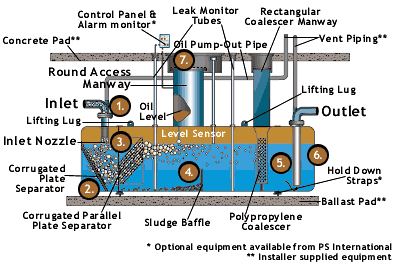How The PSI Separator Works...
|
 |
1 - Inlet and outlet piping enters the vessel through the
top centerline of the separator per UL-58 requirements. This
assures that the separator always operates full of liquid,
thus utilizing the total volume of the vessel.
back to illustration
|
 |
2 - Flow is directed towards a single corrugated plate at
an angle perpendicular to the entrance pipe. This method of
separation, known as the Buffalo-Morse Principle, serves multiple
functions.
- It reduces the velocity head of the incoming stream.
- It spreads the flow out over the entire cross sectional
area of the separator and prevents channeling of the flow.
- The plate corrugations create sinusoidal flow patterns,
which cause solids to break out of the flow stream and oil
droplets to collide and coalesce.
back to illustration |
 |
3 - The second stage of separation in the PSI separator is
based upon the proven Royal Dutch Shell Principle of using
multiple corrugated parallel plates. The parallel plate pack
in the PSI oil-water separator consists of a special arrangement
of heavy gauge removable corrugated steel plates. The plates
are inclined at a 45 degree angle to prevent the accumulation
of solids and the plate spacing is large enough to prevent
plugging from debris and trash. An open area is located directly
below the plate frame to prevent the accumulation of solids
in front of the plate pack.
The plate pack provides a crucial role in separation so it
is vital that this pack is located in the front end of the
vessel in order to maximize the effective separation chamber
of the separator. This is the case in the PSI design.
back to illustration
|
 |
4 - The internal sludge baffle in the PSI separator serves
two primary functions. First, solids are carried downstream
in the separator by the internal hydraulics of the vessel
where they collect in front of the sludge baffle. The baffle
is located directly below the access manway for easy sludge
removal from grade. Second, the sludge baffle directs the
flow from the bottom quadrant of the separator towards the
top of the vessel aiding in the floatation of small oil particles
in the flow stream.
back to illustration
|
 |
5 - PSI can provide, as an option, an aditional polypropylene
coalescer. This consists of a special matrix of polypropylene
fibers designed to coalesce oil droplets down to 20 microns
in size. An important addition to the PSI separator design
is the use of a large coalescer access manway that spans the
entire cross section of coalescer and includes dedicated tracks
for the coalescer. This ensures easy removal and reinstallation
of the coalescer from grade. Other separators require maintenance
personnel to "fish" their polypropylene coalescer
out in pieces through a small access manway. These designs
make it difficult if not impossible to reinstall the coalescers
without draining and entering the vessel.
back to illustration
|
 |
6 - The outlet pipe is located at the end of the separator
and draws clean water from the most quiescent section of the
vessel. The effluent will contain a free oil and grease discharge
of no more than 15 ppm in PS and PSR model separators
and no more than 10 ppm in PSC and PSRC model separators.
back to illustration
|
 |
7 - PSI has the experience to provide solid state control
systems to meet a wide variety of fluid level monitoring and
flow control requirements including intrinsically safe liquid
level sensors and custom-built control panels. Installing
a high performance PSI separator to meet your discharge requirements
along with a maintenance warning system will alleviate your
wastewater treatment worries.
back to illustration |